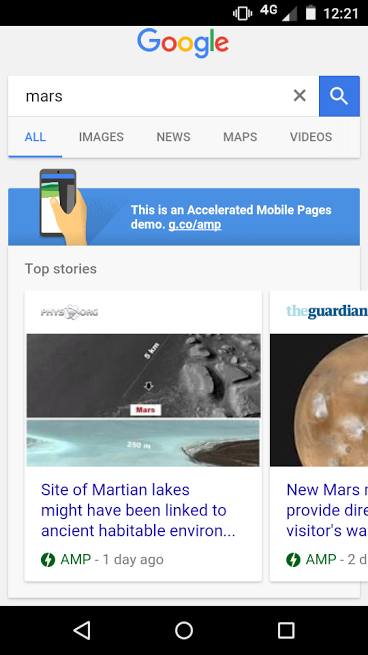Google’s Accelerated Mobile Pages (AMP) project is due to launch at the end of February, taking a huge stride towards Google’s stated goal of a “better, faster mobile internet.”
But just what will AMP consist of, and what will it mean for the marketing industry?
Last October, Google announced the introduction of its Accelerated Mobile Pages project, a new open-source initiative aiming to “dramatically improve the performance of the mobile web.”
This latest move towards a more mobile-friendly web is Google’s answer to Facebook’s Instant Articles and Apple News. But while both of those initiatives require entering into a dedicated partnership with Facebook or Apple, anyone can get on board with Google’s AMP and use it to create web pages.
In the months since the announcement, we’ve seen a lot more information released about what AMP will consist of, its key features and how it will alter the experience of the mobile web.
With a full launch of AMP due by the end of the month, now is the perfect time to get to grips with how AMP works, and how it can work to your advantage in a marketing context.
What is AMP, and what does it do?
Simply put, Accelerated Mobile Pages is a stripped-down version of the mobile web which runs on a reinvented version of the language used to create web pages: HTML.
This reimagined version of HTML, known as AMP HTML, strips out most of the elements which cause web pages to load slower on mobile, like JavaScript and third-party scripts.

The AMP version of a Guardian news article (left) vs. the regular mobile version (right)
Google boasts that a page created with AMP HTML can load anywhere from 15 to 85% faster than the non-AMP version of that page. They’ve also made it easy for web publishers to get started in AMP with a tutorial that walks you through the creation of an AMP page.
Sounds good so far. However, by stripping down the experience of using the mobile web, Google is stripping out a lot of the infrastructure advertisers and marketers currently depend on to deliver impactful brand messages to users.
But don’t despair just yet.
While some aspects of AMP will require a new approach to advertising on mobile, there are a number of other reasons why getting on board with AMP could be a good idea.
Accelerated Mobile Pages get a boost in search rankings
Since the advent of Google’s ‘Mobilegeddon’ algorithm last year, we’ve known that mobile-friendliness is a factor in search rankings, with sites that pass Google’s Mobile-Friendly Test appearing higher up the search results, and ‘unfriendly’ pages banished to the bleak wastelands of the second and third results pages.
So it follows that Accelerated Mobile Pages, which are specifically designed to load quickly and provide a great user experience on mobile, would get a serious search ranking boost. We can also see from Google’s demo of AMP search that AMP sites are highlighted with a little green lightning-bolt, inviting users in to experience these lightning-fast mobile pages.

Faster rendering equals more pageviews and more ad views
According to Kissmetrics, 40% of web users will abandon a page if it takes longer than three seconds to load, a waiting time which is likely to be exacerbated on mobile by signal issues.
So faster-loading mobile pages would seem to be in everyone’s interest – no-one is going to see an advert or read a brand message if they abandon a page before it loads.
Google’s AMP will require some re-conceptualising of digital adverts on mobile, but they won’t be going away. Google of all companies recognises the importance of online advertising. Faster-rendering pages mean more pageviews per session, which means users see more ads as a result.
And speaking of pageviews, Google is making sure that AMP traffic can be quantified and analysed just like regular web pages. AMP will have in-built native support for Google Analytics, but you’ll also be able to make use of partners such as Chartbeat, comScore and Adobe Analytics for user traffic and behaviour data.
Fine-tuning ad control
Google’s January announcement about advertising and AMP also contained some interesting details about how AMP ads will work and what publishers will be able to do with them.
“When AMP launches on Google Search in February, it will include important, basic functionalities. These include the ability to traffic ads with ad servers of your choice, support for multiple demand sources and formats (including native ads), full control over ads placements, and viewability measurement.”
This is an incredibly useful set of tools and functionalities for anyone involved in advertising, and perhaps goes to show how keen Google really is to court advertisers with the AMP project.
Google is also keen for it to be known that “20+ ad tech vendors” are already on board with AMP, including the likes of Outbrain, Taboolah and AOL.

Google is determined that ad content on AMP should be fast, secure and beautiful
But while Google is content to let publishers and marketers have control over numerous aspects of advertising, there are some parts of the ad experience that it is adamant about dictating.
In its blog post, Google sets out four “key principles” that guide its approach to advertising on AMP: it should be fast, beautiful, secure (use of HTTPS will be mandatory) and involve co-operation across the industry. The company is insistent that working according to these principles will be the key to unlocking the “next $50 billion” of advertising revenue on mobile.
In short, with the launch of Accelerated Mobile Pages, Google is very much expecting marketers to dance to its tune, and conform to its own vision of what a better mobile web should look like in order to reap the rewards.
But with faster loading speeds and better user engagement on mobile, combined with AMP’s built-in features and the clout that Google wields in the internet arena, it looks like hopping on board with AMP is a worthwhile move – as well as a relatively painless one.
The article What will Google’s Accelerated Mobile Pages (AMP) mean for marketers? was first seen from https://searchenginewatch.com
No comments:
Post a Comment